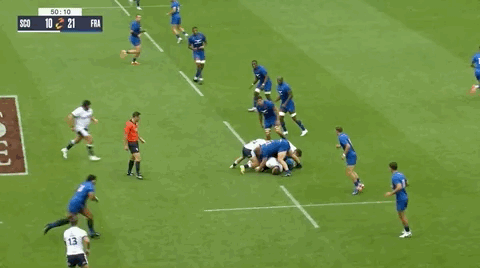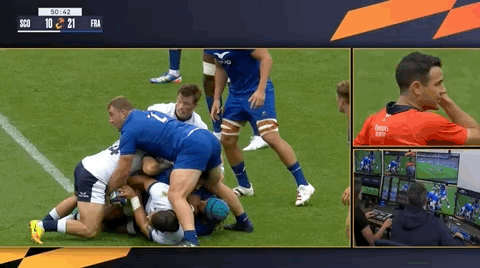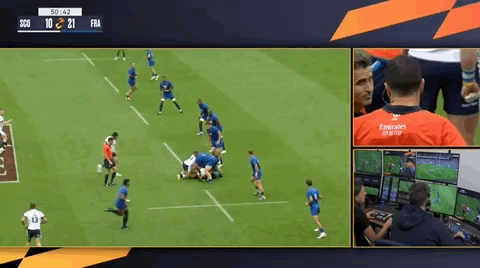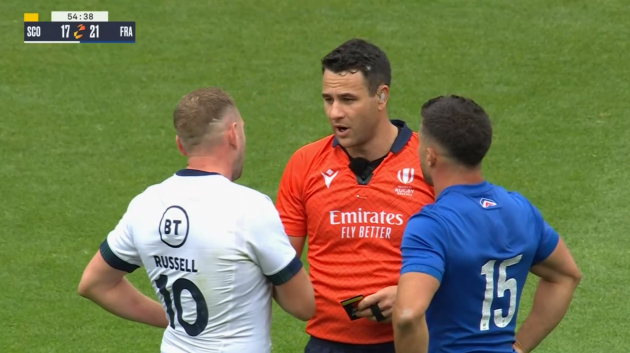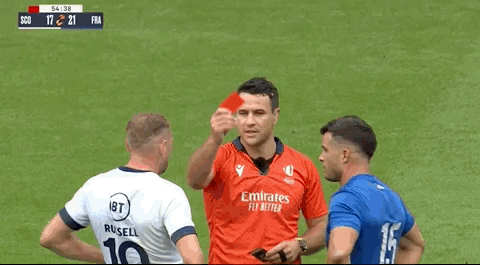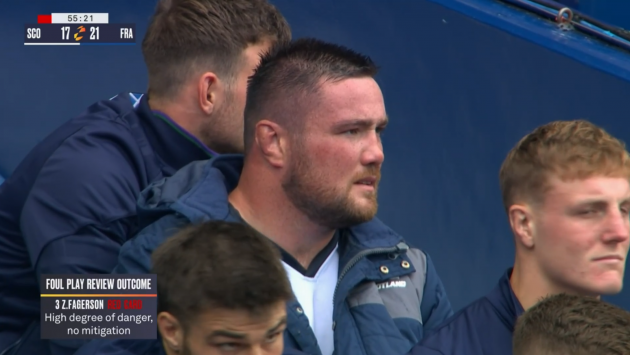ANYONE WHO HAS watched rugby in the last few years knows how tedious and interminable foul play reviews had become.
With multiple slow-motion replays and lots of back and forth between the match officials, these reviews could last for far too long. All the while, fans in the stadium and watching on TV had to wait. The players on the pitch stood idle too.
And even with the lengthy on-pitch analysis, decisions haven’t always been right. With all those eyes on them, referees have sometimes erred in their decision-making. Is it a yellow card or is it red? It can be a tough call under such pressure.
The powers-that-be felt change was needed and we’ve ended up with the new ‘bunker’ system that looks almost certain to be used at the World Cup. It’s currently being used in the warm-up games on a trial basis.
The trialling started in Super Rugby earlier this year, continued at the World Rugby U20 Championship in June and July, and on into the current warm-up matches ahead of the big show. While World Rugby hasn’t confirmed that the system will be used at the World Cup just yet, it looks like a fait accompli.
The best way to understand exactly how it works is to look at the most recent example of the bunker system in use, with Zander Fagerson sent off for making head contact at a ruck during Scotland’s win over France last weekend. He has since received a three-game ban.
The incident occurred in the 51st minute and was not picked up live by referee Ben O’Keeffe.
However, Television Match Official [TMO] Ben Whitehouse spotted the incident, with France hooker Pierre Bourgarit staying on the ground holding his face as play continued and then receiving attention from a member of the French medical team.
The ball goes out of play a few seconds later and we hear referee O’Keeffe saying, “Just responding to your ‘check, check,” which indicates that Whitehouse has notified him.
“Coming upstairs to check potential foul play,” continues O’Keeffe.
26 seconds later, the first replay pops up on the big screen in Murrayfield and for TV viewers, just as O’Keeffe says, “So you’re saying there’s head contact as well, eh?” and Whitehouse replies, “Yes, I am.”
“That’s your first angle, Ben, there’s another angle coming up,” says Whitehouse and we get a real-time replay of the incident.
Even before the second replay, O’Keeffe has turned to assistant referee Frank Murphy, and says, “I’ve got a yellow card for sure” and Murphy is clearly in agreement.
“Yep, so Ben, we’re going to go yellow card,” says O’Keeffe. “We’ve got foul play that reaches the yellow card threshold. Is there anything else that you want to show us?”
Whitehouse replies: “Two seconds Ben, the cameras will come back on you now.”
O’Keeffe approaches Scotland captain Finn Russell, who calls Fagerson over and O’Keeffe explains, “It’s foul play, it reaches the yellow card threshold, so it’s going to be a yellow card and off-field review,” as he makes the signal for that review.
All of this – from O’Keeffe responding to Whitehouse’s ‘check, check’ to Fagerson leaving the pitch – has taken just 64 seconds of real time.
O’Keeffe calls over France captain Brice Dulin and explains the situation in French.
“C’est une carton jaune et vas être revue par le bunker,” says O’Keeffe.
Interestingly, we hear Scotland skipper Russell asking if France hooker Bourgarit has to go for a Head Injury Assessment [HIA], but O’Keeffe answers that “the [French] team doctor will do that.” Bourgarit does not leave the field for a HIA.
Fagerson is now in the sin bin for 10 minutes at least while the incident of foul play is reviewed to decide whether it should be a red card. It’s not TMO Whitehouse who does this review, but a separate foul play review officer [FPRO].
World Rugby has not yet started listing FPROs with the rest of the match officials, so we don’t know who was in that role in this instance.
While Whitehouse continues to follow the game live for any further incidents, the FPRO focuses solely on the Fagerson incident. Their decision must be made within eight minutes. They can look at every angle multiple times using Hawk-Eye technology, so the incident gets great scrutiny without the pressure of everyone else watching and waiting.
In the Fagerson case, it only takes four minutes of game time for the decision to be reached. As Russell lines up the conversion of a Scottish try, O’Keeffe is notified that the FPRO has upgraded to sanction to a red card.
Russell’s kick flies between the posts and O’Keeffe says, “Can you get the camera on me now? I’m going to tell the captains.” He signals for time off and calls Russell and Dulin into the centre of the pitch.
“So the yellow card was reviewed by a TMO and it’s going to be upgraded to a red card,” explains O’Keeffe. “There’s contact with the head, he comes from distance, there’s a high degree of danger, and there’s no mitigation involved so he’s going to stay off for the rest of the game.”
O’Keeffe raises his red card in the direction of Fagerson, who has rather hopefully been keeping warm on a stationary bike.
The on-screen graphic mistakenly says Russell has been sent off initially, but that’s corrected at the next break in play.
The process in this instance was clearly smooth.
From the incident being flagged with O’Keeffe to Fagerson being off the pitch just a minute later is a welcome sign. Everyone is surely in agreement that these reviews have often taken far too long.
It’s worth noting that World Rugby has said referees should still actually show the red card themselves when it’s “clear and obvious” that’s the right decision.
But the governing body has also said that referees should use only “a small number of replays” to look at the incident. Indeed, it’s understood that they’ve specified that referees view just two replays and get on with it.
So referees will need to be 100% certain about the red card if they’re going to issue them immediately out on the pitch. In this Fagerson case, the red card does seem clear and obvious even on the first replay, but put yourself out on the pitch with the fans and TV audience watching, a player’s World Cup potentially on the line, and the fear of getting it wrong tugging at your decision-making.
With this new system, will any referee actually just show a red card out on the pitch?
It seems far less likely, although it did happen at the World Rugby U20 Champions when Ireland centre Hugh Cooney was shown a straight red card for a high tackle after French referee Luc Ramos had seen just two replays. It was impressively decisive.
Still, come a big World Cup game, it’s understandable if a referee opts to hand the review over to the bunker. Getting a decision wrong when this safety net is in place would attract even more severe backlash than has been the case.
According to World Rugby’s law book, the referee is “the sole judge of fact and of law during a match” but that definition clearly isn’t entirely accurate anymore.
Does it really matter? If red card decisions become more accurate and the process is clear and precise, with the game sped up as a result, then it surely doesn’t.
One potential issue that has been flagged is whether the FPROs will be experienced enough to make these decisions even with the relative lack of pressure. It’s understood that the positions are being filled by current TMOs, who have plenty of experience with such incidents. It might be even better if current referees doubled up as FPROs but that is probably unrealistic at this stage.
And as we’ve said before, it’s important for fans in the stadium to be fully aware of why a red-card decision has or hasn’t been reached, so it should be mandatory for the referee’s final explanation to be broadcast over the tannoy.
It’s worth pointing out that some TV viewers might actually miss the ‘drama’ of a more extensive on-field review of incidences of this nature. They have often been the biggest talking points after games. But on the whole, this shift to the bunker system is welcome.
Referees are happy to have less of a burden, coaches and players are more likely to be content with decisions, and fans should be able to see the ball back in play much quicker.

